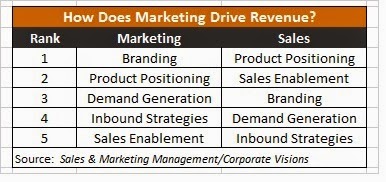Whether your objective is alignment or full-blown integration, the starting point is to understand how your marketers and salespeople currently view their roles in the demand generation process and what each group believes should be done to improve demand generation performance.
A 2013 survey by Sales & Marketing Management magazine and Corporate Visions provides valuable insights on both of these important issues. The SMM survey included almost 200 participants drawn from 15 industries. Both marketers and salespeople were asked the same questions, and the responses were segmented to illuminate where the two groups agree and disagree.
We have a tendency, I think, to believe that a vast chasm exists between marketing and sales and that the two functions operate in different worlds. While that's undoubtedly true in some organizations, my takeaway from the SMM survey is that marketers and salespeople have similar views on several important demand generation issues.
One area that shows both agreement and disagreement is the role of marketing in revenue generation. The SMM survey asked participants: How does marketing drive revenue? The table below shows how marketers and salespeople ranked five marketing strategies or activities in order of importance.
The most striking disagreement on this issue relates to sales enablement. Salespeople ranked sales enablement as the second most important marketing activity for driving revenue, while marketers ranked it dead last. Part of this disagreement can be attributed to the fact that sales enablement is still a relatively new discipline for many marketers. Also, in many companies, sales enablement content and tools are still developed in the sales or sales operations department, rather than in marketing.
An issue on which there is significant agreement between marketing and sales relates to what factors cause prospects to do business with a company. The SMM survey asked participants to select the factor (from four possible choices) that describes why prospects choose to do business with their company. The table below shows how marketers and salespeople responded.
Building a tighter relationship between marketing and sales begins by understanding where and how much your marketers and salespeople agree and disagree on important demand generation issues. The SMM survey provides valuable insights on this important issue, and you can learn more about the survey results at the Corporate Visions website.
One tool that can be very useful for uncovering agreements and disagreements between marketing and sales is an importance-performance matrix, which I described in this earlier post.





